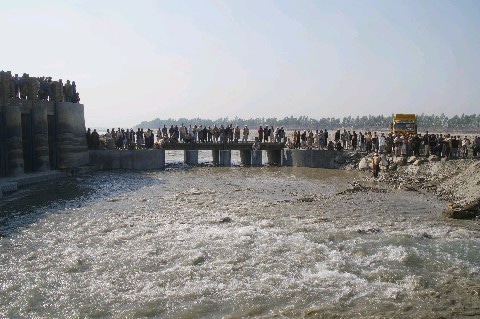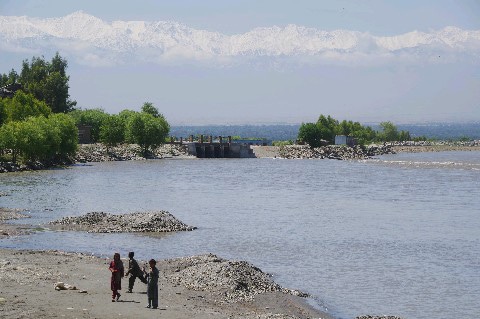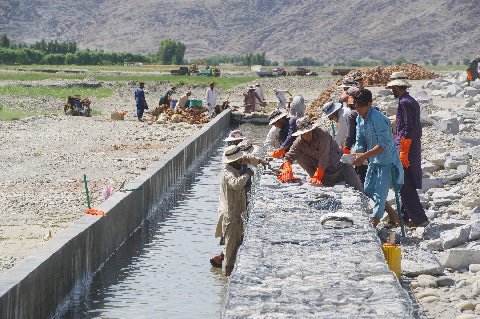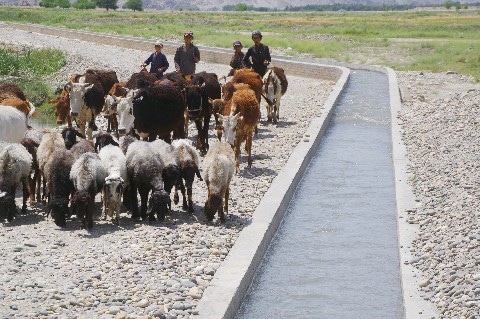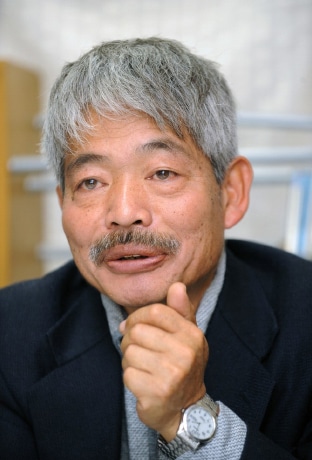【In the Land of the Afghans – Reports from Dr. Tetsu Nakamura】Fifteen years into the dream of a green expanse
Published on June 4, 2018 - The Nishinippon Newspaper
Jalalabad, the provincial capital of eastern Afghanistan, is extremely hot. Intense sunlight shines from a cloudless sky. At noon, all movement stops and the city falls silent. Locals can be found napping in the shade of trees. This year's Ramadan suffered heavily from limited rainfall. Only PMS (Peace Japan Medical Services) has been active during this holy month of fasting, but it is so hot that even our work is limited to the morning hours each day.
The familiar scenes of civil engineering work on irrigation, which is increasing year by year, continue without interruption. Fifteen years after dreaming of reviving Afghanistan’s eastern breadbasket, which had been lost to desertification, I believe this irrigation work itself has now become a local feature. So far, the 27-km long Marwarid Canal, 9 intake weirs, and 20 kilometers of the embankment have been set up. The stable irrigation system and the revival of farmland are imminent. Fifteen years have passed in the blink of an eye.
PMS was originally a medical aid organization that since the 1990s had aimed to build a medical treatment system in the mountainous regions with no doctors. However, the turning point was in 2000 when a severe drought struck. Most Afghans living in mountainous regions are subsistence farmers, therefore water shortages caused by the drought can directly lead to famine and displacement from their villages. At one point, the area around the Dara-e-Noor clinic became a wilderness where no trees and grass could grow and the villagers all became refugees. In June 2000, the World Health Organization (WHO) warned that 4 million people were at risk of starvation and one million people faced death from it. In the midst of the prevalent deaths caused by starvation, it became more than clear that medical care alone could not save lives.
Initially, we believed that the drought mitigation measures would be regarded as the immediate priority and large-scale irrigation projects would be launched across the country. The situation was that severe. Looking back, however, only a few organizations seriously worked on irrigation. The local government was not able to reach each and everyone in the remote corners of the country; nor were there any engineers to provide any advice to them. The only way out of the crisis was for the PMS to start the irrigation project in cooperation with the local people.
After all, international relief did not arrive. What came, in the following year in October 2001, were the airstrikes by the foreign military. After that, the Taliban regime collapsed and while giving the bright impression of “recovery” to the world, Afghanistan was forgotten. The conflict increased and became endless. Additionally, most of the aid organizations were not able to achieve their targets. Drug production reached record highs and security worsened terribly. The troop strength of the international military decreased from 120,000 to 10,000, yet in hushed tones, further increases have been recently discussed again.
Following this, PMS appealed for the revival of 16,500 hectares of arable land and support for the lives of 650,000 people, which we named the Green Ground Project, and presently that target has almost been achieved. During this period, when the Afghans had nowhere to turn to, PMS searched for the appropriate irrigation technology through a series of trial and error. The initial total construction cost of 2 billion yen was paid for through Japanese donations. The construction was technically modeled on the Yamada Weir (Asakura City, Fukuoka Prefecture, Japan) which was modified and adapted to the local Afghan style, and the quality of the works has improved.
In the last 15 years, the villagers who participated in the construction work have put in more than one million man-days in total. Having become so skilled, they are now producing high-quality works in a much smoother way. This group of skilled workers is the key to the dissemination of the PMS irrigation model. They are the real resource not only for the construction work but also for the maintenance of the irrigation facilities throughout the area. Thorough on-site learning is the main focus of the dissemination plan.
In response to this move, there has been a growing movement among government officials to appreciate the work of PMS. This February, the Ministry of Agriculture and the Ministry of Rural Rehabilitation and Development decided to make the PMS method, a whole set of oblique weirs and other accompanying water intake structures, a national standard. Officials of these ministries have lost patience with the inefficient reconstruction aid and fear the rapid devastation of farmlands. Modern irrigation facilities require huge budgets and maintenance costs. Given its immediate effect and economic impact, the president of Afghanistan himself advocated the use of the PMS method.
But we cannot sit back and rest on our laurels. Desertification does not seem to be stopping and the dark predictions are becoming a reality. Agricultural land relying on rainfall has been wiped out, with food security rates halved, and the number of farmers who have abandoned their lands has increased sharply, mainly among young people. In Afghanistan, where there is no major industry, this is fatal. In an economy that relies on foreign currency brought in by war and foreign aid, some people benefitted from the abuse of authority, while others were forced to make a living as hired mercenaries. This tragic structure, which relies on conflict, is not an issue that can only be blamed on terrorists or an "undemocratic climate".
The training facility operated by PMS opened in February this year, representing a big step towards the widespread adoption of our irrigation method. We welcome people regardless of their political opinions and request support from all stakeholders because we have built a relationship based on absolute trust with the local community.
“We need irrigation, not war. Time is limited.”
What PMS advocates are actual methods to sustain lives, not human rights or high ideals. We stand a chance if we keep at it. Dreaming of green fertile fields stretching into the distance, we carry on with our project.
× ×
This is a translation of a report from Afghanistan by Dr. Tetsu Nakamura, a Japanese medical doctor who was gunned down on December 4, 2019 in Afghanistan at the age of 73. Dr. Nakamura was the head of the international NGO, Peace Japan Medical Services (PMS). In addition to medical services, PMS provides various forms of assistance to local communities in Afghanistan’s eastern Nangarhar province, including the construction of irrigation systems, related agricultural programming and provision of food support. PMS is funded by Peshawar-kai, which was established in 1983 to collect donations from people and support the project implementation of Dr. Nakamura and his team.
This report is one of 27 installments in the series “In the Land of the Afghans – Reports from Dr. Tetsu Nakamura,” which ran from May 25, 2009 to December 2, 2019. They were originally published by the local newspaper in Dr. Nakamura’s hometown in Fukuoka, Japan. The text has been translated from Japanese to English, with the support of Peshawar-kai, by more than 30 volunteers, many of whom work in the field of humanitarian and development aid, and who have been and will continue to be inspired by Dr. Nakamura's work and philosophy.


